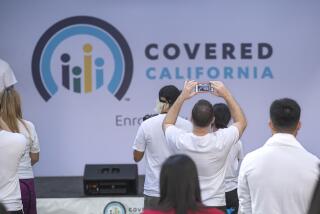New data show Obamacare gaining traction
- Share via
Here’s a rundown of the latest metrics on the Affordable Care Act.
-- The percentage of uninsured Americans is falling sharply, reaching 15.9% as of the end of February, according to Gallup. That’s the lowest rate the survey firm has measured since 2008. The greatest gains in insured status were shown by people earning less than $36,000 -- a prime target for the act -- and black Americans. Hispanics still lag.
-- The cost of health insurance and medical care came sharply down in January, according to number-crunchers at Goldman Sachs and the Commerce Department. Goldman Sachs attributed the slide to cuts in the reimbursement formulas for Medicare services, which are written into the law. The ACA is effectively putting more money in people’s pockets -- the Commerce Department estimated that the expansion of Medicaid benefits under the ACA amounted to $19.2 billion in January.
-- The grand total of Obamacare enrollees -- including insurance exchanges, Medicaid members, and young persons kept on their parents plans -- can be estimated as high as 13 million, according to independent statistician Charles Gaba, whose conclusions and methodology can be found here.
Gaba estimates the number of exchange members at somewhere between 3.65 million and 4.73 million as of the beginning of March. That makes it look plausible, if not certain, that the total will reach 6 million by the end of open enrollment, March 31. And that figure is the revised projection for 2014 enrollment from the Congressional Budget Office-- pared down from its original target of 7 million, because of the well-known technical problems suffered in October and November by the HealthCare.gov website. It’s important to remember that experts expect the pace of enrollments to pick up steam all through this month, as the deadline approaches.
-- The ACA is making increasingly deep inroads into the population of uninsured persons, not merely those who had insurance previously and have just switched over to exchange plans or Medicaid. The consulting firm McKinsey & Co. says that the previously uninsured accounted for 27% of those who told its monthly survey in early February that they had signed up for a 2014 plan; that’s up from 11% in earlier surveys. Another data point comes from New York state, one of the few breaking down its enrollments by prior insurance status -- it says more than 72% of its exchange enrollees were previously uninsured.
A few more nuggets from McKinsey: More than 75% of those who said they’ve signed up for coverage have paid their first premium, which means they’re locked in to coverage; many critics of the ACA have been suggesting that millions of enrollees will fall off the chart because they’re not paying. Looks like that’s not so.
The firm says 48% of its February respondents said they’ve enrolled in an individual plan, up from 37% in January and 19% in November. More interestingly, of those who say they’re likely to enroll before the deadline, 65% are currently uninsured.
And here’s something for Obamacare marketers and other outreach personnel to keep in mind: The most common reason people give for not enrolling is the perceived cost of a health plan, but by McKinsey’s reckoning more than 80% who gave that reason are eligible for a subsidy, and two-thirds of those didn’t know they were eligible, or didn’t know how much the subsidy would be.
These findings, taken together, tell you that the ACA is beginning to achieve its aims of reducing the number of uninsured Americans and restraining healthcare costs. It’s packing its biggest punch among those who’ve been kept out of the individual market because of its cost. The findings also point to the challenges facing healthcare officials at all levels -- get out the message to under-served communities and keep the trend lines rising.
If you want to know why the Obamacare horror stories you’ve heard often don’t seem to hold up, these figures tell you why. What they don’t say is whose interest is served by continuing the effort to scare people? Not the average American’s, that’s for sure.
More to Read
Inside the business of entertainment
The Wide Shot brings you news, analysis and insights on everything from streaming wars to production — and what it all means for the future.
You may occasionally receive promotional content from the Los Angeles Times.











